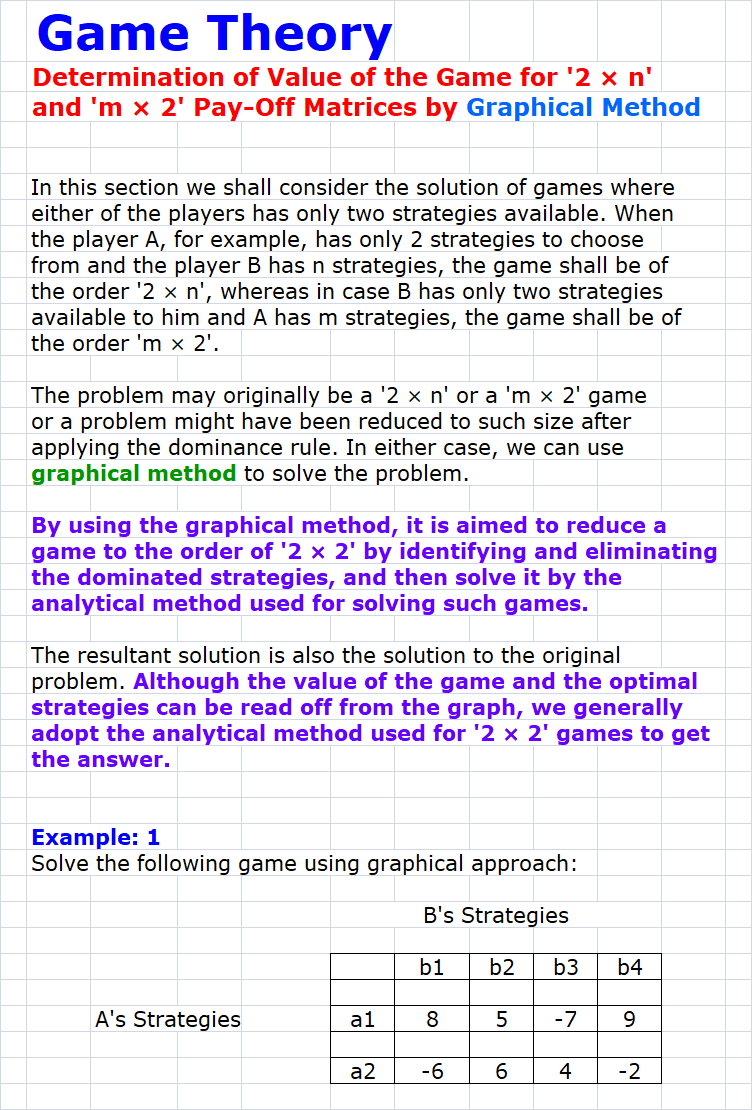Game Theory
Introduction
Game theory is
a body of knowledge which is concerned with the study of decision-making in
situations where two or more rational opponents are involved under conditions
of competition and conflicting interests. It deals with human processes in
which an individual decision-making unit, who can be an individual, a group, a
formal or informal organization, or a society, is not in complete control of
the other decision-making unit(s), the opponent(s), and is addressed to
problems involving conflict or competition at various levels.
A game refers
to a situation in which two or more players are competing. It involves the
players (the decision makers) who have different goals or objectives and whose
fates are intertwined. They are in a situation in which there may be a number
of possible outcomes with different values to them. Although they might have
some control that would influence the outcome, they do not have complete
control over others. Labour unions striking against the company management,
players in a chess game, army generals engaged in fighting the enemy, a firm
striving for larger share of market in duopolistic market conditions and so on,
all illustrate the situations which can be viewed as games.
In a game
situation, each of the players has a set of strategies available. A strategy
refers to the action to be taken by a player in various contingencies in
playing a game. There is a set of outcomes each of which is the result of the
particular choices of strategies made by the players on a given play of the
game, and pay-offs are accorded to each player in each of the possible
outcomes.
The players in
the game strive for optimal strategies. An optimal strategy is such as provides
the best situation in the game in the sense that it involves maximum pay-off to
each of the players.
There are several
game theory models which can be classified on the basis of factors like:
1)
The
number of players involved,
2)
The
sum of gains and losses, and
3)
The
number of strategies employed in the game.
Classification
based on the number of players involved
In a game situation, interests of two or more than two
participants may be in conflict. If interests of two participants are in
conflict, the game is called a two-person game
and if interests of more than two participants are in conflict, the game is
known as an n-person game. Here, ‘n’ does
not necessarily imply that in the game exactly n people would be involved but
rather that the participants can be classified into n mutually exclusive
categories and members of each of the categories have identical interests.
Classification
based on the sum of gains and losses
In a game, if the sum of gains and losses is equal to
zero, it is called zero-sum game. For example, if
two chess players agree that at the end of the game the loser would pay Rs 50
to the winner, it would mean a zero-sum game; a gain of one player exactly
matching the loss of the other. If the sum of gains and losses is not equal to
zero, it would obviously be called a non-zero-sum game.
Classification
based on the number of strategies
The games can also be classified on the basis of the
number of strategies. A game is said to be finite game,
if each player has the option of choosing from only a finite number of
strategies, otherwise it is called infinite game.
In this article, we shall deal with two-person zero-sum games involving finite strategies
open to the players.
Two-Person
Zero-Sum Game
As stated earlier, a two-person zero-sum game is the
one which involves two persons (players) and where the gain made by one equals
the loss incurred by the other. To illustrate, suppose that there are two firms
A and B in an area which, for a long period in the past, have been selling a
competing product and are now engaged in a struggle for a larger share of the
market. Now with the total market of a given size, any share of the market
gained by one firm must be lost by the other, and, therefore, the sum of the
gains and losses equals zero.
Pay-off Matrix
with a Saddle Point
Click here for the Game Theory Pay-off Matrix in PDF
Solution: 1
Solution: 2







No comments:
Post a Comment